Comprehensive Analysis of Aberrantly Expressed Competitive Endogenous RNA Network and Identification of Prognostic Biomarkers in Pheochromocytoma and Paraganglioma
- PMID: 33192072
- PMCID: PMC7654541
- DOI: 10.2147/OTT.S271417
Comprehensive Analysis of Aberrantly Expressed Competitive Endogenous RNA Network and Identification of Prognostic Biomarkers in Pheochromocytoma and Paraganglioma
Abstract
Background: Long non-coding RNA (lncRNA) functions as a competitive endogenous RNA (ceRNA) and plays an important role in the biological processes underlying tumorigenesis. However, studies describing the function of lncRNA in pheochromocytoma and paraganglioma (PCPG) remain largely unknown. Our study aims to construct a regulatory ceRNA network and explore prognostic biomarkers for PCPG through a comprehensive analysis.
Methods: PCPG data from The Cancer Genome Atlas (TCGA) were utilized to obtain differentially expressed lncRNAs (DElncRNAs), microRNAs (DEmiRNAs), and mRNAs (DEmRNAs). Kaplan-Meier analysis was used to detect prognostic biomarkers and Cytoscape was utilized to construct a regulatory network of ceRNA. Potential lncRNA-miRNA-mRNA axes were inferred by correlation analysis. GO and KEGG pathways were constructed using "clusterProfiler" and "DOSE" R-packages. Immunohistochemistry (IHC) staining was performed to validate differential protein expression levels of genes in the axes. Finally, the GSE19422 dataset and Pan-Cancer data were applied to validate the expression pattern and survival status of mRNAs, respectively.
Results: A total of 334 DElncRNAs, 116 DEmiRNAs, and 3496 DEmRNAs were identified and mainly enriched in hormone secretion, metabolism signaling, metastatic and proliferative pathways. Among these differentially expressed genes, 16 mRNAs, six lncRNAs, and two miRNAs were associated with overall survival of patients with PCPG and sequentially enrolled in the ceRNA network. Two lncRNA-miRNA-mRNA regulatory axes were predicted: AP001486.2/hsa-miR-195-5p/RCAN3 and AP006333.2/hsa-miR-34a-5p/PTPRJ. The GSE19422 dataset and IHC analysis validated that mRNA and protein levels of RCAN3 and PTPRJ were upregulated in PCPG tissues compared with adjacent adrenal gland medulla tissues. Pan-Cancer data showed that the upregulated expression of RCAN3 and PTPRJ was associated with favorable overall survival and disease-free survival.
Conclusion: A regulatory lncRNA-miRNA-mRNA ceRNA network was successfully constructed and 24 prognostic biomarkers were identified for PCPG patients. These findings may contribute toward a better understanding of the biological mechanism of tumorigenesis and enable further evaluation of the prognosis of patients with PCPG.
Keywords: ceRNA network; pheochromocytoma and paraganglioma (PCPG); prognostic biomarker.
© 2020 Wang et al.
Conflict of interest statement
The authors declare that they have no conflict of interest.
Figures
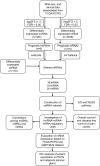





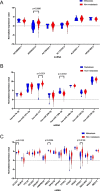
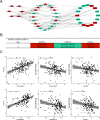
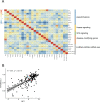


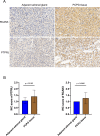
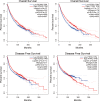
Similar articles
-
LncRNA-Associated ceRNA Network Reveals Novel Potential Biomarkers of Laryngeal Squamous Cell Carcinoma.Technol Cancer Res Treat. 2020 Jan-Dec;19:1533033820985787. doi: 10.1177/1533033820985787. Technol Cancer Res Treat. 2020. PMID: 33371795 Free PMC article.
-
Competitive endogenous RNA network identifies four long non-coding RNA signature as a candidate prognostic biomarker for lung adenocarcinoma.Transl Cancer Res. 2019 Aug;8(4):1046-1064. doi: 10.21037/tcr.2019.06.09. Transl Cancer Res. 2019. PMID: 35116848 Free PMC article.
-
A Competing Endogenous RNA Network Reveals Novel lncRNA, miRNA and mRNA Biomarkers With Diagnostic and Prognostic Value for Early Breast Cancer.Technol Cancer Res Treat. 2020 Jan-Dec;19:1533033820983293. doi: 10.1177/1533033820983293. Technol Cancer Res Treat. 2020. PMID: 33371806 Free PMC article.
-
Reconstruction and Analysis of the Differentially Expressed IncRNA-miRNA-mRNA Network Based on Competitive Endogenous RNA in Hepatocellular Carcinoma.Crit Rev Eukaryot Gene Expr. 2019;29(6):539-549. doi: 10.1615/CritRevEukaryotGeneExpr.2019028740. Crit Rev Eukaryot Gene Expr. 2019. PMID: 32422009 Review.
-
Meta-analysis of transcriptomics data identifies potential biomarkers and their associated regulatory networks in gallbladder cancer.Gastroenterol Hepatol Bed Bench. 2022;15(4):311-325. doi: 10.22037/ghfbb.v15i4.2292. Gastroenterol Hepatol Bed Bench. 2022. PMID: 36762219 Free PMC article. Review.
Cited by
-
The Role of the Metabolome and Non-Coding RNA on Pheochromocytomas and Paragangliomas: An Update.Metabolites. 2022 Feb 1;12(2):131. doi: 10.3390/metabo12020131. Metabolites. 2022. PMID: 35208206 Free PMC article.
-
Identification of Recurrence-Related mRNAs and Noncoding RNAs in Hepatocellular Carcinoma Following Liver Transplantation.Turk J Gastroenterol. 2023 Apr;34(4):394-405. doi: 10.5152/tjg.2023.22656. Turk J Gastroenterol. 2023. PMID: 37089051 Free PMC article.
-
From diagnosis to resistance: a symphony of miRNAs in pheochromocytoma progression and treatment response.Naunyn Schmiedebergs Arch Pharmacol. 2024 Apr;397(4):1957-1969. doi: 10.1007/s00210-023-02759-0. Epub 2023 Oct 6. Naunyn Schmiedebergs Arch Pharmacol. 2024. PMID: 37801146 Review.
-
MicroRNAs, Long Non-Coding RNAs, and Circular RNAs: Potential Biomarkers and Therapeutic Targets in Pheochromocytoma/Paraganglioma.Cancers (Basel). 2021 Mar 26;13(7):1522. doi: 10.3390/cancers13071522. Cancers (Basel). 2021. PMID: 33810219 Free PMC article. Review.
-
HERV-W ENV Induces Innate Immune Activation and Neuronal Apoptosis via linc01930/cGAS Axis in Recent-Onset Schizophrenia.Int J Mol Sci. 2023 Feb 3;24(3):3000. doi: 10.3390/ijms24033000. Int J Mol Sci. 2023. PMID: 36769337 Free PMC article.
References
LinkOut - more resources
Full Text Sources

